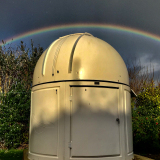INDI Library v2.0.7 is Released (01 Apr 2024)
Bi-monthly release with minor bug fixes and improvements
Tips for Auto-Focus
- Peter Kennett
-

- Offline
- Supernova Explorer
-

- Posts: 1000
- Thank you received: 155
Replied by Peter Kennett on topic Tips for Auto-Focus
Please Log in or Create an account to join the conversation.
- Peter Kennett
-

- Offline
- Supernova Explorer
-

- Posts: 1000
- Thank you received: 155
Replied by Peter Kennett on topic Tips for Auto-Focus
You need to know how many steps YOUR focuser needs to go from an ideal HFR (smallest value obtainable) to 2 times that number.
This is first done by moving the focuser in small amounts and manually capturing images and noting the HFR values. Once you know how many focuser steps you need to double the HFR - the rest is easy.
This is how I set mine up, There may be other ways or methods - but this technique works VERY well for my setup. Obviously your actual values will be different, but the technique should work.
Attachments:
Please Log in or Create an account to join the conversation.
- Nigel Dunmore
-

- Offline
- Premium Member
-

- Posts: 155
- Thank you received: 12
Replied by Nigel Dunmore on topic Tips for Auto-Focus
Please Log in or Create an account to join the conversation.
Replied by John on topic Tips for Auto-Focus
I'm wondering if the 2x HFR "rule" that you use to setup focus would be more generally applicable to SCTs. If so, I can update the focus documentation. It would be interesting to hear your comments Nigel as you and Peter almost bookend the size range of generally available SCTs.
(Small point but just FYI, Linear and Linear 1 Pass don't use Max Step Size).
Please Log in or Create an account to join the conversation.
- Peter Kennett
-

- Offline
- Supernova Explorer
-

- Posts: 1000
- Thank you received: 155
Replied by Peter Kennett on topic Tips for Auto-Focus
Please Log in or Create an account to join the conversation.
- Peter Kennett
-

- Offline
- Supernova Explorer
-

- Posts: 1000
- Thank you received: 155
Replied by Peter Kennett on topic Tips for Auto-Focus
I think my 2X rule is for long focal length scopes - such as an SCT with an OAG. I am imaging at either 0.8 or 0.4 arc seconds per pixel, and so small changes in HFR are noticeable.
Please Log in or Create an account to join the conversation.
- Nigel Dunmore
-

- Offline
- Premium Member
-

- Posts: 155
- Thank you received: 12
Replied by Nigel Dunmore on topic Tips for Auto-Focus
do linear and linear 1 use the max travel ?
I’ve noticed max step size being greyed out at times but not took much notice of it, but max travel seems to be available all the time.
Regards
Nigel
Please Log in or Create an account to join the conversation.
Replied by John on topic Tips for Auto-Focus
Max Travel is used by Linear and Linear 1 Pass. The idea is to provide some protection for focusers that don't know the max / min position. I think now most focusers have their own protection and if asked to move outside the min/max range wouldn't do it. I would recommend setting it above the normal range that the focuser would travel during a focus run. The algorithm will attempt to recover if you impede the range of movement it wants to use but there's no real benefit to this... just set the step size and number of steps appropriately and let the algorithm do its thing.
Please Log in or Create an account to join the conversation.
- Mark Aston
-

- Offline
- New Member
-

- Posts: 16
- Thank you received: 0
Replied by Mark Aston on topic Tips for Auto-Focus
Can you clarify for me what tools in the focus module best cope with diffraction annuli as the focus is automatically moved in and out of optimum HRF for a scope with central obscuration - in my case an 8” RC?
Reading the evolving discussion between yourself, Peter and Nigel, and looking at the online documentation, I’m not entirely sure whether there is a mechanism in each algorithm to determine the outer diameter of an annulus (donut)? What I am finding with an obviously course focusing iOptron electronic focuser is that EKOS passes a point where it stops measuring the enclosed energy of the donut and limits itself to part of the donut (or indeed determines if can no longer detect a star).
I’m really just looking for guidance on what are the critical variables per implemented algorithm that are most appropriate for obscured catadioptrics?
Many thanks
Mark
Please Log in or Create an account to join the conversation.
- Nigel Dunmore
-

- Offline
- Premium Member
-

- Posts: 155
- Thank you received: 12
Replied by Nigel Dunmore on topic Tips for Auto-Focus
Peter etal have more experience of this than me as I’ve only just got a focuser so you might want to take what I say with a pinch of salt….
The way I see it you need to move far enough from focus to get hfr’s that produce a V. Peters said how he does it and from his graph he gets a nice V. Me with my simpler equipment I’ve yet to get a proper V but I am developing an understanding of how this works now so maybe I will come up with an initial steps setting etc which works.
However I suspect that to get enough of a change in hfr I will stray into donut territory which leads to problems. Now I believe to handle those I need to pick/tweak the appropriate SEP settings. To do that I’m aiming to take some images that are out of focus to see what helps count the whole donut rather than just little bits. I’ve tried reading the ‘do not panic’ guide to SEP but obviously that’s for phd level people so I’m going to have to do some poking until I get an idea…unless of course someone else has already worked it out.
Regards
Nigel
Please Log in or Create an account to join the conversation.
Replied by John on topic Tips for Auto-Focus
I'm most familiar with the SEP star detection mechanism. I can't say its the "best" method but I think its the most commonly used. I don't use a scope with a central obstruction myself but from analysis of focus captures of others I am aware that when you move out of focus and get donuts the star detection mechanism starts to detect parts of the annuli as smaller stars so that the mechanism breaks down.
There are no simple ways around this.
You can see this point by moving steadily more and more out of focus. As you do so the average HFR increases as expected... but then will flatten and potentially will start to fall. When it starts to flatten you are at the point at which the star detection algorithm begins to fail so when you set parameters for an autofocus run you need to stay away from this point as it will "corrupt" the curve fitting, irrespective of algorithm.
As you go out of focus the number of stars detected will drop off as well. So don't go so far as to be left with a small number. Again this depends heavily on the imaging scale.
As a general rule, SCTs need to operate within a tighter range of motion about the point of best focus than refractors.
So the game is getting the maximum HFR change without getting the donut corrupting effect. Then I'd start with 4 or 5 datapoints either side of the focus point. Peter is using 3 which from a curve fitting perspective is quite low. The compromise here is more datapoints equals less sensitivity to a single "bad" datapoint but takes longer. Peter has high quality equipment and knows what he is doing so can push the envelope a little more.
I use multiple stars (full frame), use weights and either hyperbola or parabola. If Linear 1 Pass works for you then it is likely to be accurate.
I think the default SEP profile (1-Focus-default) is the place to start. I have played around with this quite a bit. If you have the time and patience you will be able to improve on it but you'll need to invest the time to understand the concepts of extraction, deblending and photometry. Its one of the things I'm working on at the moment. I think using a better convolution filter may well cope better with donuts but there are compromises to doing this such as picking up more noise as faint stars. Tuning these parameters is quite tricky and likely to be setup specific. Its also only going to give very "marginal gains" to focus.
Please Log in or Create an account to join the conversation.
- Mark Aston
-

- Offline
- New Member
-

- Posts: 16
- Thank you received: 0
Replied by Mark Aston on topic Tips for Auto-Focus
I have been playing with EKOS focus module for quite a while now and your, Peter and Nigel’s comments have been very helpful. However, it appears there are two specific attributes of my RC setup that have exposed difficulties:
(1) The iOptron stepper motor belt-driving the focuser is quite course in real terms
(2) The central obscuration of an RC is bigger than those of newts, cass, SCTs, and Maks. This means that the diffraction donut is a much greater % of the out-of-focus image area and becomes more apparent, more quickly, than other designs as you move thro’ focus.
The courser step resolution of the iOptron set-up exacerbates the issue, and I may well just move to a ZWO EAF as installed on my large refractor and Mak-Cass.
However, given the success Peter has with a large SCT even pushing the boundaries, as you put it, it does beg the question if EKOS focus module could include an option to measure only the outer diameter of the diffraction annulus, once the HFR starts to flatten out, in a future update?
I have no doubt I can further refine the settings to better focus my RC set-up, and will actively play with this (once I get a clear night!); it is important to note that I also use NINA and a couple of other autofocus programmes on my observatory PC that do noticeably work better than EKOS. This appears to be mainly due to EKOS detecting sub-sections of the annulus (as you noted) sooner in the thro’ focus process than the other programmes.
I really wanted to move to the more stable implementation of EKOS on a RasPi and retire the PC that struggles in a remote coastal observatory, hence am very keen to see if EKOS can work with my RC - it does focus nicely with the other scopes by the way…
All the best
Mark
Please Log in or Create an account to join the conversation.

